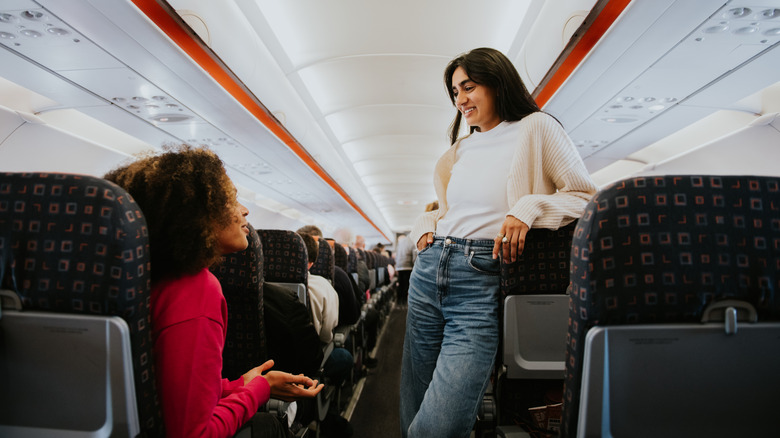A Surgeon's Tip For Choosing The Best Airplane Seat For Your Spine
No matter the destination, seasoned travelers know that surviving a long-haul flight has its own set of challenges and discomforts. From the constant shifting in cramped seats to negotiating with seatmates for bathroom breaks, there's no telling what might happen once you hit the skies. After all, the combination of limited legroom, fixed seating positions, and extended periods of inactivity are usually guaranteed to turn even the simplest journeys into a pretty strenuous and uncomfortable ordeal. And that's precisely why choosing the best airline seat for your travel style is so important when you're facing double-digit hours in the air, especially if you're hoping to avoid that dreaded post-flight back pain. Thankfully, there's a solution for that — and it's all backed by science.
In conversation with Fodor's Travel, spine surgeon Dr. Alpesh Patel at Northwestern Medicine revealed the secret to in-flight back comfort. And no, it doesn't (necessarily) involve fancy neck pillows. Citing better posture and the ability to stand up and move around freely as two key factors, Dr. Patel explained that the best seat for spine safety is, in fact, the aisle seat. This unfortunately means that you probably won't want to book the window seat for your next flight — even if the sky-high views are calling your name.
The aisle seat gives you more freedom to move
When it comes to spinal health during flights, movement matters more than you might think. That said, Dr. Patel points out that sitting puts substantial pressure on your lower back — about three to five times more force than when you're standing. This explains why you feel particularly stiff after sitting down for too long — whether you've been clicking away at your laptop during a long workday or soaring 35,000 feet in the air.
With all of this in mind, choosing an aisle seat becomes your best ally in combating this pressure. After all, picking an aisle seat means you won't have to climb over other passengers (or awkwardly gesture to get their attention) when you need to stretch your legs. Plus, it also means you'll be a lot less likely to simply sink into your chair and stay seated if your seatmate is sleeping and you're too nervous to wake them up.
More tips to prevent in-flight back pain
Even with the best seat selection, back pain can still happen during long flights. That's why Dr. Patel also suggests several additional strategies you can try to help keep your back comfortable and happy. For starters, the spinal surgeon suggests arriving at your gate at least 20 minutes before boarding and taking some time for a simple stretching routine: this includes gentle moves like lunges and hip openers, which will help loosen your lower back before you settle into your seat. Once onboard, additional in-seat stretches like seated twists, butt lifts, and the "superhero pose" can keep you limber and pain-free.
Along with this, what you carry (and how you carry it) also matters. And while checking your luggage might seem like an unnecessary expense, carrying a too-heavy backpack, dumping all your belongings into an overweight tote bag, or wrestling with an oversized carry-on can all strain your back before you even board. So don't overdo it and try to do your best to pack light – your lower back, neck, and shoulders will be grateful in the long run.
Lastly, once you're onboard, having a pack of over-the-counter pain relievers can also make a difference. As a precaution, Dr. Patel suggests taking a standard dose before your flight, with the option to take more during the journey if you start to feel the pain creep up. For immediate relief, a pair of hand warmers (yes, they're TSA approved) can act as an effective heating pad that'll help relax your lower back muscles.


